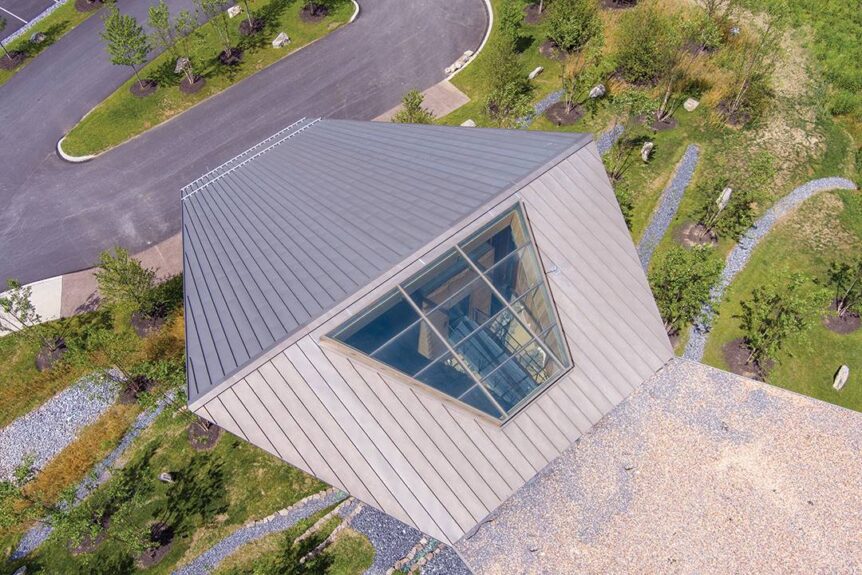Houck Services helps build a one-of-a-kind building in Pennsylvania
In Japanese culture, pine trees are revered as symbols of longevity; bonsai trees are believed to provide luck; and evergreens are associated with samurai clans to represent power and perseverance. There are many Japanese folklores involving sacred trees being passed down through generations. Japanese people always have had profound adoration and respect for all aspects of nature.
When JST, an international electrical connector company founded in 1957 in Kurayoshi, Japan, needed more space for its Pennsylvania operations, it purchased property in Swatara Township with plans to build a 52,000-square-foot facility in the shape of a tree.
Designed by Ryuichi Ashizawa Architects, Osaka, Japan, the building resembles a tree branching out—a representation of the company’s growth—when viewed from above. This aerial aesthetic is important because the facility only is a few miles from Harrisburg International Airport and will be seen by many people as they fly into and out of the city.
JST selected Houck Services Inc., Harrisburg, Pa., as the roofing contractor to help construct the extraordinary building.
EPDM
Houck Services began work on JST’s production engineering center in August 2019. The project had specific and unique roofing specifications that required precision and attention to detail.
For example, when choosing the ballast stone, Houck Services submitted samples for consideration. The building owners wanted a unique look for the roof and ultimately chose Timberlite lava rocks in shades of red, white and yellow.
Once the roof framing was complete, Houck Services team members mechanically attached one layer of polyisocyanurate insulation and then adhered a second layer to achieve an R-30 value rating. To maintain roofline consistency and facilitate water runoff, workers tapered the insulation around the roof area’s perimeter.
Next, team members adhered Firestone Building Products 45-mil-thick EPDM membrane to the insulation. Workers then placed a Firestone Protection Mat followed by Timberlite lava rocks for aesthetic purposes. To add more weight to the lightweight lava rocks, workers mixed in 20% 2B Limestone (1 1/2-inch stone aggregate).
PROJECT NAME: JST Production Engineering Center
PROJECT LOCATION: Middletown, Pa.
PROJECT DURATION: August 2019-June 2020
ROOFING CONTRACTOR: Houck Services Inc., Harrisburg, Pa.
ROOF SYSTEM TYPES: EPDM membrane, PAINT GRIP metal panels
ROOFING MANUFACTURERS: Brock Associates LLC, Pittsburgh; Firestone Building Products, Nashville, Tenn.
Metal
The portion of the building representing the root of the tree was to be covered with a metal panel roof system. The building owner wanted a rusted patina appearance, so Houck Services chose an uncoated, bonderized and phosphatized metal also known as PAINT GRIP to achieve the desired look.
Houck Services located a supplier that was able to obtain the coils to fabricate standing-seam metal panels. The panels were tapered on the front side of the roof from 18 inches at the peak to 10 inches at the eave. Workers mechanically seamed the panels with a double-lock seam.
Houck Services craftsmen custom fabricated a tube-shaped drain and installed it partway down the metal roof to allow rainwater to be diverted inside the building as part of a unique water fountain feature. All the edge metal, gravel stops and fascia panels also were made from PAINT GRIP and custom fabricated by Houck Services craftsmen in the company’s sheet-metal shop.
In addition, the building owner wanted icicles to form on the edge of the roof’s eave during winter. To accomplish this, workers drilled holes in the metal gravel stop. About 5,000 3/4-inch holes were drilled into 1,250 linear feet of edge metal at 3 inches on center to achieve the artistic element.
A Japanese tradition
In June 2020, Houck Services completed work on the grand project. Near the completion of building construction, a “topping out” ceremony was held where the final beam to be placed on the building was signed by everyone involved in the project.
As part of an 800-year-old Japanese tradition, a small tree was placed on top of the beam, and a bottle of saké from Japan was poured over the board before it was installed to honor a job well done.
“The most rewarding part of the project was providing the general contractor and owner with solutions to their various ideas,” says Tom Wolfe, estimator and project manager for Houck Services. “The topping out ceremony was extremely satisfying. The experience of signing the final piece of lumber installed on the building, ceremonial saké poured on the wood and unique design of the building all added up to a one-of-a-kind experience.”

